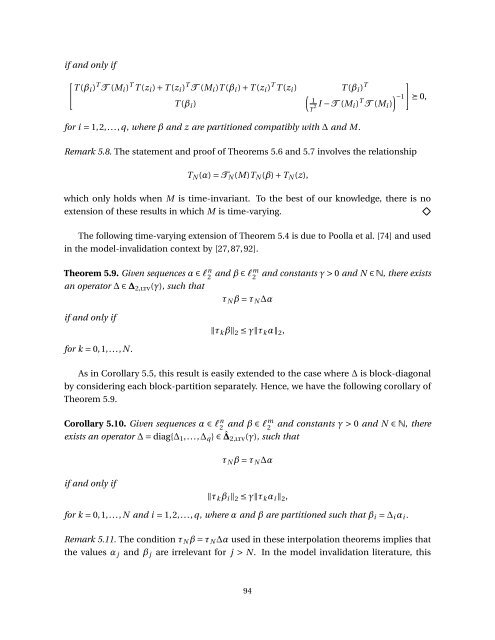Probabilistic Performance Analysis of Fault Diagnosis Schemes
Probabilistic Performance Analysis of Fault Diagnosis Schemes
Probabilistic Performance Analysis of Fault Diagnosis Schemes
Create successful ePaper yourself
Turn your PDF publications into a flip-book with our unique Google optimized e-Paper software.
if and only if<br />
[ T (βi ) T T (M i ) T T (z i ) + T (z i ) T T (M i )T (β i ) + T (z i ) T T (z i ) T (β i ) T ]<br />
( ) −1<br />
T (β i )<br />
1<br />
I − T (M<br />
γ 2 i ) T ≽ 0,<br />
T (M i )<br />
for i = 1,2,..., q, where β and z are partitioned compatibly with ∆ and M.<br />
Remark 5.8. The statement and pro<strong>of</strong> <strong>of</strong> Theorems 5.6 and 5.7 involves the relationship<br />
T N (α) = T N (M)T N (β) + T N (z),<br />
which only holds when M is time-invariant. To the best <strong>of</strong> our knowledge, there is no<br />
extension <strong>of</strong> these results in which M is time-varying.<br />
The following time-varying extension <strong>of</strong> Theorem 5.4 is due to Poolla et al. [74] and used<br />
in the model-invalidation context by [27, 87, 92].<br />
Theorem 5.9. Given sequences α ∈ l n 2 and β ∈ lm 2<br />
and constants γ > 0 and N ∈ N, there exists<br />
an operator ∆ ∈ ∆ 2,ltv (γ), such that<br />
τ N β = τ N ∆α<br />
if and only if<br />
‖τ k β‖ 2 ≤ γ‖τ k α‖ 2 ,<br />
for k = 0,1,..., N .<br />
As in Corollary 5.5, this result is easily extended to the case where ∆ is block-diagonal<br />
by considering each block-partition separately. Hence, we have the following corollary <strong>of</strong><br />
Theorem 5.9.<br />
Corollary 5.10. Given sequences α ∈ l n 2 and β ∈ lm 2<br />
and constants γ > 0 and N ∈ N, there<br />
exists an operator ∆ = diag{∆ 1 ,...,∆ q } ∈ ˆ∆ 2,ltv (γ), such that<br />
τ N β = τ N ∆α<br />
if and only if<br />
‖τ k β i ‖ 2 ≤ γ‖τ k α i ‖ 2 ,<br />
for k = 0,1,..., N and i = 1,2,..., q, where α and β are partitioned such that β i = ∆ i α i .<br />
Remark 5.11. The condition τ N β = τ N ∆α used in these interpolation theorems implies that<br />
the values α j and β j are irrelevant for j > N. In the model invalidation literature, this<br />
94













